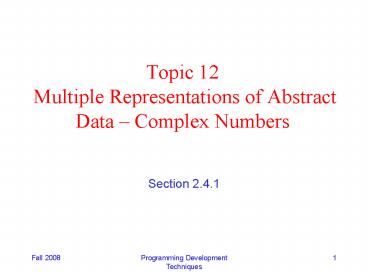Topic 12 Multiple Representations of Abstract Data - PowerPoint PPT Presentation
Title:
Topic 12 Multiple Representations of Abstract Data
Description:
Title: cisc882 Lecture 1 Author: Kathy McCoy Last modified by: Kathleen F. McCoy Created Date: 1/20/1999 7:57:44 PM Document presentation format: On-screen Show – PowerPoint PPT presentation
Number of Views:33
Avg rating:3.0/5.0
Title: Topic 12 Multiple Representations of Abstract Data
1
Topic 12 Multiple Representations of Abstract
Data Complex Numbers
- Section 2.4.1
2
Multiple representations for abstract data
- Implementation of complex numbers as an example
- Illustrates how one representation can be better
for one operation, but another representation
might be better for another operation - (Scheme already has complex numbers, but we'll
pretend that it doesn't)
3
Complex numbers (math view)
- z x i y
(rectangular form) - r eia
(polar form) - x
real part of z - y
imaginary part of z - r
magnitude of z - a
angle of z
Imaginary
Z
r
y
a
Real
x
4
Complex number arithmetic
- Addition addition of coordinates add real
parts and imaginary parts - z1 z2 x1 iy1 x2 iy2
- (x1 x2) i(y1 y2)
- Multiplication easier to think of in polar form
- z1 z2 r1eia¹ r2eia²
- (r1 r2)ei(a¹ a²)
5
SO?
- There are two different representations of
complex numbers. - Some operations on complex numbers are easier to
think of in terms of one operation and others in
terms of the other representation. - Yet all operations for manipulating complex
numbers should be available no matter which
representation is chosen. - Want to have access to each part real,
imaginary, magnitude, angle no matter which
representation is chosen.
6
Two representations
- Rectangular
- make-from-real-imag - constructor
- real-part selector
- imag-part selector
- Polar
- make-from-mag-ang constructor
- magnitude selector
- angle selector
- Two different representations possible for the
same number.
7
Addition
- adds together two complex numbers
- uses the representation of addition of
coordinates - in terms of real and imaginary parts
- (define (add-complex z1 z2)
- (make-from-real-imag
- ( (real-part z1) (real-part z2))
- ( (imag-part z1) (imag-part z2))))
8
Subtraction
- subtract one complex number from another
- uses the representation of subtraction of
- coordinates in terms of real and
- imaginary parts
- (define (sub-complex z1 z2)
- (make-from-real-imag
- (- (real-part z1) (real-part z2))
- (- (imag-part z1) (imag-part z2))))
9
Multiplication
- multiplies two complex numbers
- uses the representation as polar form
- in terms of magnitude and angle
- (define (mul-complex z1 z2)
- (make-from-mag-ang
- ( (magnitude z1) (magnitude z2))
- ( (angle z1) (angle z2))))
10
Division
- divides one complex number from another
- uses the representation as polar form
- in terms of magnitude and angle
- (define (div-complex z1 z2)
- (make-from-mag-ang
- (/ (magnitude z1) (magnitude z2))
- (- (angle z1) (angle z2))))
11
Choose a representation
- We must implement constructors and selectors in
terms of primitive numbers and primitive list
structure. - Which representation should we use??
- Rectangular form (real part, imaginary part
good for addition and subtraction) - Polar form (magnitude and angle good for
multiplication and division) - Either representation OK as long as we can select
out all of the pieces we need real, imaginary,
magnitude, angle
12
Rectangular Representation
- lower level implementation
- RECTANGULAR FORM REPRESENTATION
- takes a real and imaginary part and
- creates a complex number represented
- in rectangular form
- (define (make-from-real-imag x y)
- (cons x y))
13
Rectangular Representation (cont)
- given an imaginary number in
- rectangular form
- returns the real part
- (define (real-part z) (car z))
- given an imaginary number in
- rectangular form
- returns the imaginary part
- (define (imag-part z) (cdr z))
14
Rectangular Representation (cont)
- given an imaginary number in rectangular form
- return the magnitude (using trigonomic rels)
- (define (magnitude z)
- (sqrt ( (square (real-part z))
- (square (imag-part z)))))
- given an imaginary number in rectangular form
- return the angle (using trigonomic rels)
- (define (angle z)
- (atan (imag-part z) (real-part z)))
15
Rectangular Representation (cont)
- takes a magnigude and an angle and
- creates a complex number
- represented in rectangular form
- (define (make-from-mag-ang r a)
- (make-from-real-mag
- ( r (cos a))
- ( r (sin a))))
16
Polar representation
- lower level implementation
- POLAR FORM REPRESENTATION
- takes a magnigude and an angle and
- creates a complex number represented
- in polar form
- (define (make-from-mag-ang r a) (cons r a))
17
Polar Representation (cont)
- given an imaginary number in
- polar form
- return the magnitude
- (define (magnitude z) (car z))
- given an imaginary number in
- rectangular form
- return the angle
- (define (angle z) (cdr z))
18
Polar Representation (cont)
- given an imaginary number in
- polar form
- returns the real part
- (using trignomic rels)
- (define (real-part z)
- ( (magnitude z) (cos (angle z))))
- given an imaginary number in
- polar form
- returns the imaginary part
- (using trigonomic rels)
- (define (imag-part z)
- ( (magnitude z) (sin (angle z))))
19
Polar Representation (cont)
- takes a real and imaginary part and
- creates a complex number represented
- in polar form (harder)
- (define (make-from-real-imag x y)
- (make-from-mag-ang
- (sqrt ( (square x) (square y)))
- (atan y x)))
20
Which Representation?
- Note either representation will work fine.
- Notice that some of the selectors/constructors
are easier with one representation over the other - But, no matter which is used, our basic
operations will still work.






























